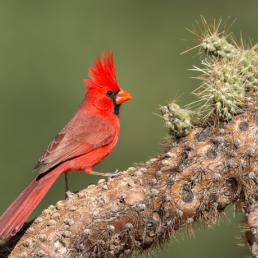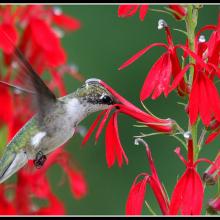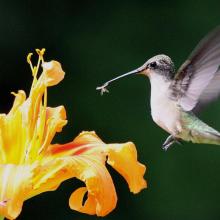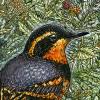

Join BirdNote tomorrow, November 30th!
Illustrator David Sibley and actor H. Jon Benjamin will face off in the bird illustration battle of the century during BirdNote's Year-end Celebration and Auction!
Hummingbirds are built for hovering flight, with flexible wrists that rotate their wings in a rapid figure-eight motion that generates almost constant lift. Eurasian Skylarks, on the other hand, hovers by fluttering its wings 10-12 times per second, singing all the while. Some raptors such as American Kestrels use a different strategy: by flying into the wind, they can float in place while they scan for prey.
BirdNote®
Hovering Is Hard Work
Written by Bob Sundstrom
This is BirdNote.
Hummingbirds make hovering look effortless. They’re built for it, with flexible wrists that rotate their wings in a rapid figure-eight motion, generating almost constant lift.
[Ruby-throated Hummingbird wing hum, https://m.youtube.com/watch?v=2n71TgeWXd0, 0:04-0:09]
But wind tunnel experiments with flying birds show that hovering is hard work! As one scientist put it, a hovering hummingbird “represents the upper limit of aerobic locomotion in vertebrates.”
[Ruby-throated Hummingbird wing hum, https://m.youtube.com/watch?v=2n71TgeWXd0, 0.04-.09]
In other words, hummingbirds are athletes on par with galloping horses or humans running a marathon. But hummingbirds aren’t the only flyers up to the challenge. Eurasian Skylarks even sing while hovering, sometimes for minutes on end.
[Eurasian Skylark, ML 203489821, 0:02-0:09]
Different from a hummingbird, a lark flutters its wings 10 to 12 times per second, relying entirely on lift produced by the downstroke.
Other small birds hover briefly. In search of insects, tiny birds like kinglets float above the tips of branches for just a few seconds.
[Ruby-crowned Kinglet call, XC 522476, 0:02-0:03]
Even larger birds like hawks and kites make use of head-on breezes in what’s called “wind hovering,” when they search the ground for prey. The kestrel is a master of wind hovering. Flapping forward but counterbalanced by the wind, the kestrel appears tethered to the ground by a string.
[American Kestrel, ML 275548381, 0:26-0:29]
So while hummers might be the most impressive hoverers, they’re not the only birds to employ this gravity-defying maneuver.
For BirdNote, I’m Ariana Remmel.
###
Senior Producer: John Kessler
Content Director: Allison Wilson
Producer: Mark Bramhill
Associate Producer: Ellen Blackstone
Managing Producer: Conor Gearin
Bird sounds provided by The Macaulay Library of Natural Sounds at the Cornell Lab of Ornithology, Ithaca, New York. Eurasian Skylark ML203489821 recorded by J. Rochefort, Ruby-crowned Kinglet Xeno Canto 522476 recorded by J. Swackhamer, and American Kestrel ML 275548381 recorded by M. Grosselet.
BirdNote’s theme was composed and played by Nancy Rumbel and John Kessler.
© 2022 BirdNote February 2022 Narrator: Ariana Remmel
ID# flight-16-2022-02-11 flight-16
References:
https://jeb.biologists.org/content/213/16/i (wind tunnel study)
https://royalsocietypublishing.org/doi/10.1098/rsos.170307
https://pubmed.ncbi.nlm.nih.gov/12124359/ (quoted)
http://blogs.bu.edu/bioaerial2012/2012/12/08/2655/
https://www.birdnote.org/explore/field-notes/2012/09/things-wings-can-t…
https://www.google.com/amp/s/www.livescience.com/amp/3877-hummingbirds-…








